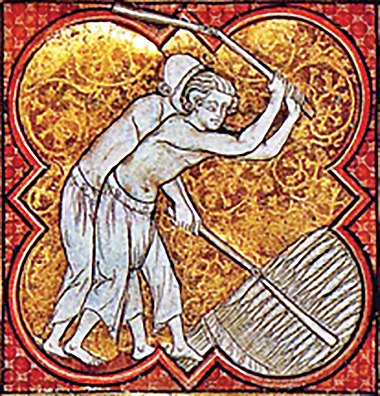
Museum archives: Henry le Calewe and the Agricultural Year.
Henry le Calewe was one of the villeins who, some seven hundred years ago, in return for the rental of a cottage and a 7 acre plot of land, was obliged to carry out work for the manor of Wiston.He did all those things described in the Museum article in July’s Your Steyning – harvesting and mowing (with a scythe of course), apple picking and ditching. But he did much more: there was little in the agricultural year which he was not expected to turn his hand to.
‘He shall do carryings as often as the lord shall wish, provided that he can return to his own home at evening and, if not, the lord shall find for him and his horse, sustenance.’ Most of the ‘carrying’ must have been to bring the harvested crops into the barn for threshing and storage but he was clearly expected to go further afield if needed. ‘He shall carry from Knepp or the forest of St. Leonard as far as Wistneston [Wiston] 2 wainloads of wood.’ The rental goes into such minute detail on every aspect of the manor’s life that we know just how much of the wheat, barley, oats, rye, beans and vetches, which Henry le Calewe had helped to harvest, he was then required to thresh. During ‘1 work’, for instance, he had to thresh 8 bushels of oats but only 4 of wheat.
Only one crop was not grown for food or animal fodder. That crop was flax. Henry had to ‘dig and roll the flax land and to carry the flax to water with the lord’s cart and to lay it in the water, draw out, dry and bind it and make all ready, and keep the flax seed for delivery to the reeve.’ Flax is the raw material for linen thread – linen being a valued commodity in the days before cotton, as a fibre from which cool clothes could be made. To preserve as much of the fibre as possible the flax plants were pulled rather than scythed and, to soften the woody part of the stem so that it could be separated from the useful flax fibre, the plants then had to be well soaked. This apparently was one of those particularly smelly operations which would have formed a backdrop to the agricultural year. The list of Henry’s obligations did not include the spinning and the weaving, which were women’s work. The seeds, separated by the threshing, were kept for planting the following year – hence the instruction to deliver them to the manorial official – the reeve.
Another major activity was cheese making. Twice a year ewes were gathered together ‘on 10 acres of stubble’ for this purpose – the gathering being known as a ‘herdwick’. On the manor of Wiston this involved 200 ewes for each ‘herdwick’. To provide for the making of the cheese the manor had to play its part: ‘the lord shall find, at the said ‘herdwicks’, 4 bushels of salt and motes (possibly ‘moulds’) and churns. And the aforesaid ‘herdwicks’ shall render to the lord one ‘pey’ of cheese for every 40 ewes’. A ‘pey’, being a measure of 256 lbs., this suggests that more than half a ton of cheese was produced at each ‘herdwick’! One small aside shows that the ‘herdwicks’ were not one day events. ‘Every Saturday, while the herdwick lasts, 2 dishes of butter’ must be provided ‘and the bearer of that butter shall have his breakfast.’
All these activities were measured in ‘works’ and these, in turn, were linked to achieving particular results. So each man, during ‘one work’ had to labour long enough to complete a pre-determined task, the length of which could vary depending on his skill level, the weather and many other factors. In this way, throughout the year,
Henry le Calewe would have been tied inextricably to the manor’s agricultural calendar. It would take a seismic event in the form of the Black Death 30 or 40 years later to significantly shake this order of things.

